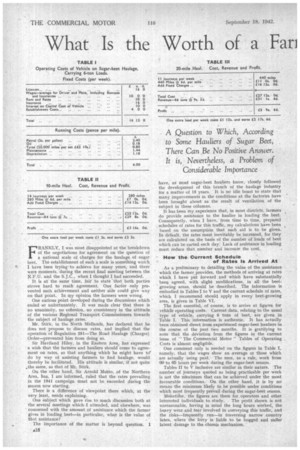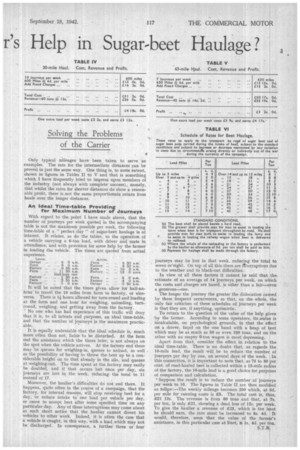What Is the Worth of a Fan r's Help in Sugar-beet Haulage?
Page 20

Page 21

If you've noticed an error in this article please click here to report it so we can fix it.
FRANKLY, I was most disappointed at the breakdown of the ikegotiations for agreement on the question of a national scale of charges for the haulage. of sugar beet. The establishment of such a scale is something wilich, 8.. I have been trying to achieve for many years, and there were moments. during the recent final meeting between the N.F,U, and the S.J.C., when I thought I had succeeded.
It is at the same time, fain to state "that both parties strove hard to reach agreement. One factor only prevented such achievement and neither side could give way on that point. In my opinion the farmers were wrong.
One curious point developed during the discussions which ended so unfortunately. It was made clear that there is no unanimity, no cohesion, no consistency in the attitude of the various Regional Transport Commissioners towards the subject of haulage rates.
Mr. Stirk, in the North Midlands, has declared that he does not propose to discuss rates, and implied that the operation of Regulation 25I—The Road Haulage (Charges) Order—prevented him from doing so.
Sir Haviland Hiley, in the Eastern Area, has expressed a wish that the farmers and hauliers should come to agreement on rates, so that anything which he might have to' do by way of assisting farmers to find haulage, would thereby be facilitated. His attitude is similar, if not quite ,the same, as that of Mr. Stirk, On the other hand, Sir Arnold Mira°, of the Northern Area, has, I am informed, ruled that the rates prevailing in the 1941 campaign must not be exceeded during the season now starting.
There is a difference of viewpoint there which, at the very least, needs explaining.
One subject which gave rise to much discussion both at the several meetings whichl attended, and elsewhere, was ' concerned with the amount of assistance which the farmer gives in loading beet—in particular, what is the value of that assistance? have, as most sugar-beet hauliers know, Closely followed the development of this branch of the haulage industry for a matter of 15 years. it is no idle boast to state that many improvements in the conditions at the factories have been brought about as the result of ventilation of the subject in these columns.
It has been my,experience that, in most districts, farmers do provide assistance to the haulier in loading the beet. Consequently, when I have, from time to time, prepared schedules of rates for this traffic, my calculations have been based on the assumption that such aid is to be given.. In default, the rates must inevitably be. increased, for they are calculated on the basis of the number of loads of beet which can be carted each day: Lack of assistance in loading must reduce that number and increase the cost.
How the Current Schedule of Rates Is Arrived At
As a preliminary to detailing the value of the assistance which the farmer. provides, the methods of arriving at rates which I have pit forward and which have substantially been agreed, with, slight modifications, in all the beetgrowing areas, should be described. The information is• embodied in Tables 1 to V and the current schedule of rates, which I recommend should apply in every beet-growing area, is given in Table VI.
The first essential, of course, is to arrive at figures for vehicle operating costs. Current data, relating to the usual type of vehicle, carrying 6 tons of beet, are given in Table I. This information is authentic. It has actually been obtained direct from experienced sugar-beet hauliers in the course of the past two months. It is gratifying to note that the deviation from the figures in the current issue of "The Commercial Motor" Tables of Operating Costs is almost negligible.
One comment only is needed on the figures in Table I. namely, that the wages show an average or those which are actually being paid. The men, as a rule, work from 00 to 65 hours per week during the sugar-beet season.
Tables II to V inclusive are similar in their nature. The number of journeys quoted as being practicable per week is not the maximum that can he achieved under the most favourable conditions. On the other hand, it is by no means -the minimum likely to be possible under conditions which most frequently prevail during the sugar-beet season.
Meantime, the figures are there for, operators and other interested individuals to study. The profit shown is not unreasonable, having in mind the long hours worked, the heavy wear and tear involved in conveying this traffic, and the risks—frequently run—in traversing narrow country lanes, where the lorry is liable to be bogged and suffer latent damage to the chassis mechanism. Only typical mileages have been taken to serve as examples. The rate for the intermediate distances can be proved in just the same way. One thing is, to some extent, shown in figures in Tables IT to V and that is something which I have frequently tried to impress upon members of the industry (not always with complete success), namely, that whilst the rates for shorter distances do show a reasonable profit, there is not the same proportionate return from hauls over the longer distances.
An Ideal Time-table Providing for Maximum Number of Journeys With regard to the point I have made above, that the number of journeys per week quoted in the accompanying table is not the maximum possible per week, the following time-table of a " perfect day " of sugar-beet haulage is of interest. It relates, as do the tables, to the operation of a vehicle carrying a 6-ton load, with driver and mate in attendance, and with provision for some help by the farmer in loading the vehicle. The times are quoted from actual experience.
Factory .......1 30 p.m. Ferns ... 2 0 p.m.
Farm ... .. 3 30 P.m. Factory .. 4 0 p.m. Factory 5 0 p.m. Garaga 5 30 p.m.
It will be noted that the times given allow for half-anhour to travel the 10 miles from farm to factory, or viceversa. There is lj hours allowed for turn-round and loading at the farm and one hour for weighing, unloading, turn. round. weighing, and getting away from the factory.
' No one who has had experience of this traffic will deny that it is, to all intents and purposes, an ideal time-table, and that the number of journeys is the maximum practic
able. '
It is equally undeniable that the ideal schedule is, much more often than not, liable to be disturbed. At the farm end the assistance which the times infer, is not always on the spot when the vehicle arrives. At the factory end there may be queues for weighing-in, queues to unload, as well as the possibility of having to throw the beet up to a considerable height on to that already in the silo, and queues at weighing-out. The time spent at the factory may easily be doubled, and if that occurs but once per day, six journeys are lost in the week, reducing the total to 11 instead of 17.
Moreover, the haulier's difficulties do not end there. It happens, quite often in the course of a campaign, that the factory, for internal reasons, will stop receiving beet for a day, or reduce intake to one load per vehicle per day, or cease to accept beet after some specified time on any particular day. Any of these interruptions may come about at such short notice that the haulier cannot divert his vehicles to other work. Indeed, it is often the case that a vehicle is caught, in this way, with a load which may not be discharged. In consequence, a further three or four journeys may be lost in that week, reducing the total to seven or'eight. On top of all this there are interruptions due to the weather and to black-out difficulties.
In view of all these factors it cannot be said that the estimate of an average of 14 journeys per week, on which the costs and charges are based, is other than a fair—even a generous—one.
The longer the journey the greater the dislocation caused by these frequent occurrences, so that, on the whole, the only fair criticism of these schedules of journeys per week is that they are, if anything, optimistic.
To return to the question of the value of the help given by the farmer. According to some operators, its value is incalculable, on psychological grounds, in that the effect on a driver, faced on the one hand with a heap of beet which may be as much as 50 or even 100 tons, and on the other with an empty 6-ton wagon is most depressing.
Apart from that, consider the effect in relation to the ideal time-table. There is no doubt that, as regards the 10-mile lead, the result will be to reduce the number of journeys per day by one, on several days of the week. In this connection, it is important to note that, as 75 to 80 per cent. of road-hauled beet is collected within a 15-mile radius of the factory, the 10-mile lead is a good choice for purposes of comparison and calculation.
• Suppose the result is to reduce the number of journeys per week to 10. The figures in Table II are then modified as follow:—The weekly mileage becomes 200 which, at 6d. per mile for running costs is £5. The total cost is, thus, £21 12s. The revenue is from 60 tons and that, at 7s. per ton, is only £21, showing a dead loss of 12s. per week. To give the haulier a revenue of £25, which is the least he should earn, the rate must be increased to 8s. 4d. It would, therefore, seem that the value of the farmer's assistance, in this particular case at least, is is. 4d. per ton.




















































